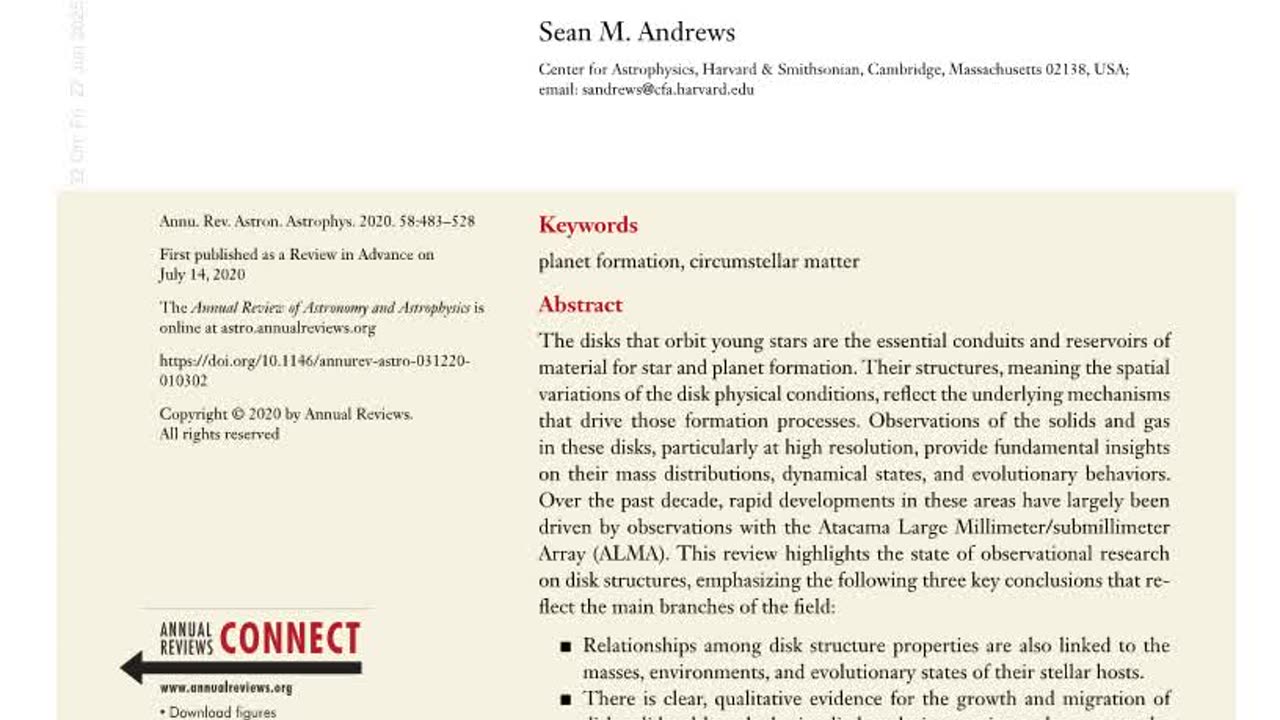Premium Only Content

Observations of Protoplanetary Disk Structures. A Puke(TM) AUdiopaper
Complete files at Archive:
https://archive.org/details/observations-protoplanetary-disks
Annual Review of Astronomy and Astrophysics.
Observations of Protoplanetary Disk Structures.
Sean Andrews.
14 July 2020
https://www.annualreviews.org/content/journals/10.1146/annurev-astro-031220-010302
Keywords: planet formation, circumstellar matter.
Abstract.
The disks that orbit young stars are the essential conduits and reservoirs of material for star and planet formation. Their structures, meaning the spatial variations of the disk physical conditions, reflect the underlying mechanisms that drive those formation processes. Observations of the solids and gas in these disks, particularly at high resolution, provide fundamental insights on their mass distributions, dynamical states, and evolutionary behaviors.
Over the past decade, rapid developments in these areas have largely been driven by observations with the Atacama Large Millimeter, submillimeter Array, ALMA. This review highlights the state of observational research on disk structures, emphasizing the following three key conclusions that reflect the main branches of the field:
Relationships among disk structure properties are also linked to the masses, environments, and evolutionary states of their stellar hosts.
There is clear, qualitative evidence for the growth and migration of disk solids, although the implied evolutionary timescales suggest the classical assumption of a smooth gas disk is inappropriate.
Small-scale substructures with a variety of morphologies, locations, scales, and amplitudes presumably tracing local gas pressure maxima, broadly influence the physical and observational properties of disks.
The last point especially is reshaping the field, with the recognition that these disk substructures likely trace active sites of planetesimal growth or are the hallmarks of planetary systems at their formation epoch.
Section One. INTRODUCTION.
1 point 1. Motivation.
The formation and early evolution of stars and planetary systems are mediated by interactions with their circumstellar material. That material is organized in a flattened disk of gas and solids that orbits the central host star. Although these interactions between stars, planets, and disks are brief, lasting 10 Mega years, they are literally foundational. Such mutual influences set some stellar and planetary properties that persist for billions of years. The hallmarks of the processes that govern these links are imprinted on the disk structures, meaning the spatial distributions and physical conditions of the disk material. Detailed observations enable measurements of those structures, their environmental dependencies, and their evolutionary behavior. Coupled with theoretical simulations and complemented by the collective knowledge of stellar populations, exoplanets, and primitive bodies in the Solar System, those measurements help map out how disks shape star and planet formation.
These disks and their initial structures are seeded when a star is made. Star formation begins with the gravitational collapse of an overdense core in a molecular cloud. An initial nudge that imparts some core rotation means that material collapsing from its outer regions, with higher angular momentum, is channeled onto a disk rather than the protostar itself. In that sense, disks are simple consequences of angular momentum conservation.
Measurements of young disk structures, still embedded in their natal core material, can reveal much about the starformation process: Their sizes help distinguish the roles that magnetic fields have in regulating core collapse, their masses help constrain protostellar accretion rates, and their density distributions encode the angular momentum transport that ultimately determines the stellar mass.
Disks are also the material reservoirs and birthplaces of planetary systems. The prevalence, formation modes, masses, orbital architectures, and compositions of planets depend intimately on the physical conditions in the disk at their formation sites, the evolution of that disk structure, locally and globally, and the planetary migration driven by dynamical interactions with the disk material. Measurements of the disk mass, its spatial distribution, and its demographic dependencies offer crucial boundary conditions for models of planet formation. Combined with the properties observed in the mature exoplanet population, that information can help develop and refine a predictive formation theory despite the considerable complexity of the associated physical processes.
1 point 2. Observational Primer.
In these and many other ways, disk structures offer profound insights on how the properties of stars and planetary systems are shaped by their origins. This review focuses on the recent landscape of observational constraints on disk structures: how relevant measurements are made, what they suggest about disk properties, and how those properties are connected to star and planet formation. The most valuable measurements employ data with high angular resolution, as the typical nearby distance of approximately 150 parsec disk subtends about 1 arc second on the sky. Most of any given disk is cool enough, less than 100 Kelvin, that it emits efficiently at sub millimeter wavelengths. Coupling these small angular sizes and cool temperatures, this review emphasizes radio interferometry as an essential tool. Indeed, progress over the past decade has largely been driven by the commissioning of the transformational Atacama Large Millimeter submillimeter Array (ALMA) facility.
Three categories of observational tracers are used to study disk structures: scattered light, thermal continuum emission, and primarily molecular spectral line emission. The first two are sensitive to the physical conditions and distribution of the solids, and the third is used to measure the properties of the gas. Figure 1 shows a schematic diagram that highlights the basic aspects of disk structure and the two-dimensional locations where these tracers originate. Each of these probes is sensitive to different materials and physical conditions, ensuring considerable diversity in the disk appearance when viewed in different tracers. An illustrative example is shown in Figure 2.
Figure 1.
A diagram of a disk structure viewed in cross-section. The gas is denoted in grayscale, and solids are marked with exaggerated sizes and colors. The left side highlights the approximate locations of emission tracers, the right side defines some structure and contents terminology.
Figure 2
The morphology of the TW Hydrae disk is compared in three different tracers:
(a) lambda equal to 1.6-micron scattered light from small dust grains .
(b) lambda equal to 0.9-millimeter continuum from pebble-sized particles, and
(c) the Carbon Monoxide J equal to 3 to 2 spectral line emission tracing the molecular gas.
Each panel spans 500 Astronomical Units on a side, resolutions are shown in the lower-left corner of each panel, they are very small in panels a and b. It is helpful to compare these emission distributions with the behavior in the Figure 1 schematic.
1 point 2 point 1. Scattered light.
Small, approximately micrometer-sized, dust grains suspended in the gas at a suitable altitude in the disk atmosphere reflect the radiation emitted by the host star. This scattered light is sensitive to the radial variation of the vertical height of the dust distribution, Section 4 point 3.
The spectral and polarization behavior of the scattered light constrain the albedos, set by the sizes, shapes, and compositions of the grains, Section 4 point 2. The practical advantage of this tracer is resolution: adaptive optics systems operating near the diffraction limit on 8 to 10 meter telescopes measure features at 30 to 50-milli-arc second scales, approximately 5 Astronomical Units at the typical distances of nearby star-forming regions, approximately 150 parsec. The important challenges include the following: contrast with the host star, preventing measurements in the innermost disk, 10 Astronomical Units, sensitivity at large radii, due to the dilution of the stellar radiation field, and technical limits on the host-star brightness. Taken together, those issues bias the current sample of resolved scattered-light measurements toward disks with more massive hosts.
1 point 2 point 2. Continuum emission.
Disk solids emit a thermal continuum that spans four decades in wavelength, lambda approximately 1 micron to 1 centimeter. Most of that emission is optically thick and, therefore, a temperature diagnostic. Optical depths, Tau sub nu, decrease with lambda, the transition to Tau sub nu is less than around one is traditionally expected at sub millimeter wavelengths. In the optically thin limit, the intensity I sub nu, scales with the surface density of solids, Sigma s, Sections 2 point 1 and 2 point 3, and its spectral dependence is sensitive to the solid particle properties, Section 4 point 3. This tracer is bright, accessible at high resolution, to 10 to 20 milli-arc-seconds, or approximately 2 Astronomical Units, and has no stellar contrast limitations. Accordingly, measurements are plentiful: Much of the collective knowledge about disk structures is based on millimeter continuum data. The disadvantages arise from ambiguities in the detailed particle properties and the validity of the optically thin approximation, Sections 4 and 5.
1 point 2 point 3. Spectral line emission.
The most abundant molecule in a disk, Hydrogen, does not have a permanent dipole moment and does not emit efficiently over the vast majority of the disk volume.
The bulk of the gas in a disk is essentially dark, and there is no direct probe of its mass reservoir.
Instead, measurements rely on the spectral line emission from sub millimeter rotational transitions of rare tracer molecules. Optically thick line intensities are sensitive to the temperature in the atmospheric layer that corresponds to the line photosphere, Section 2 point 4.
At low optical depths, line intensities are a function of both temperature and density. If the abundance of a given species relative to Hydrogen denoted here as Xj for molecule j, is known, spatially resolved maps of optically thin line emission constrain the gas surface density profile, Sigma g, Sections 2 point 1 and 2 point 3. Furthermore, spectrally resolved line emission can be used to tomographically reconstruct the disk velocity field, Section 2 point 5.
ALMA is now capable of resolving emission lines at tens of milli-arc-second scales, approximately 5 Astronomical Units, in velocity channels only a few meters per second wide, but the narrow bandwidths and low abundances of trace molecular species mean that sensitivity is a perennial challenge for disk measurements.
Accordingly, line measurements of disks are much less common than for the continuum. The most prominent obstacles in interpreting spectral line data are high optical depths, confusion with the emitting layer height, when resolution is limited, and the large, potentially orders of magnitude) uncertainties in the molecular abundances (Xj).
1 point 3. Statement of Scope.
Keeping in mind the motivations for measuring disk structures and the observational tools that are now available, this review covers four broad, and interrelated, topics that occupy much of the effort in the disk research community: inferred physical characteristics of disk structures and their ambiguities, Section 2, empirical constraints on evolutionary and environmental dependencies based on demographics studies, Section 3, evidence for, and problems with, the growth and migration of disk solids, Section 4, and the properties and roles of small-scale substructures in shaping observables and facilitating planet formation, Section 5. The review concludes with a brief synopsis that summarizes the current state of the field and some suggestions of potentially fruitful avenues for future work.
Section Two. KEY STRUCTURE PROPERTIES.
The spatial distribution of mass, the density structure, is without question the fundamental property of interest for disks. The conceptual orientation of the entire field presumes that disk evolution is deterministic: In principle, a collection of density structure measurements that span an appropriate range of environmental and evolutionary states could be used to work out the mechanics of key evolutionary processes. This section of the review is focused on the underlying motivations, observational constraints, and lingering ambiguities associated with the mass distributions in disks, Sections 2 point 1 to 2 point 3. The intrinsic connections, physical and observational, between the density structure and the thermal and dynamical state of the disk material are summarized in Sections 2 point 4 and 2 point 5, respectively.
NOTATION, CONVENTIONS, AND NOMENCLATURE.
To simplify discussions, variable notations are used throughout this review. Cylindrical coordinates define the disk frame of reference for these properties, where r, theta, and z correspond to the radial distance from the star, the azimuthal angle around the disk, and the height above the disk midplane, respectively. Many structural and observational properties vary in three dimensions. To minimize complexity and avoid confusion, the convention is to explicitly note spatial dependencies only when the spatial behavior is directly relevant, for example, most discussion presumes azimuthal symmetry.
For example: T is shorthand for the local value T( Of R, theta and Phi), T( Of r) refers to a radial profile at a given position, for example the midplane, or generic z, depending on the context, and Average T refers to a disk-averaged quantity The integral of T over the volume.
2 point 1. Mass.
With a limited number of resolved disk measurements, more emphasis is placed on masses than density distributions. Nevertheless, the key issues can be illustrated from this coarser perspective. Masses offer elementary constraints on the future contents of planetary systems. The current census of exoplanets finds an abundance of worlds orbiting other stars, but the metamorphosis of disk material into planetary systems is unclear without a comparison of the available mass reservoirs in the parent and descendant populations. Summing the masses of terrestrial planets and giant planet cores in the Solar System, or an ensemble of exoplanets, offers a conservative lower bound on the solid mass expected in their progenitor disks, Mass of solids greater than around 40 Earth Masses.
Extrapolations of the current planetary atmosphere compositions to the primordial gas expected in disks give an analogous bound for the gas masses, Mass of gasses greater than around 3,000 Earth Masses.
Solids are a minor contributor to the mass budget, with an initial mass fraction of approximately 1 percent relative to the gas. But the fundamental roles they play in all aspects of disk evolution and planet formation justify special attention to their mass reservoirs. The optimal Mass of solids diagnostic is the luminosity of the millimeter continuum emission, L millimeter. In the optically thin limit, the continuum intensity scales like Intensity at nu is proportional to kappa at nu times B nu (Of Temperature) times Sigma s, where kappa nu is the absorption opacity, B nu (Of Temperature) is the Planck function at temperature T, and Sigma s is the surface density of solids. Integrating that emission over the disk volume shows that the continuum emission L millimeter is proportional to the mass of solids. Figure 3 shows the Mass of solids distribution inferred from millimeter continuum photometry surveys for 887 disks. Although that distribution is subject to considerable ambiguities, see below, and biased by observational and physical selection effects, Section 3, it offers rough guidance on typical values of the Mass of solids.
Estimates of Mass of solids are intrinsically uncertain because they rely on assumptions about the properties of the emitting particles. A detailed discussion of those properties, encapsulated in the absorption opacity, is deferred to Section 4, but the standard approach is to adopt a reasonable estimate that maximizes the average of Kappa of nu.
Figure 3.
Cumulative distributions of disk solid, M S, and gas, M G, masses. The Mass of solids distribution (purple) includes 887 disks in Ophiuchi, Tauris, Lupis, Chamaeleon, I C 348 located in Perseus, and Upper Scorpius. The continuum emission L millimeter measurements at lambda equal to 0.9 millimeter (or 1.3 millimeter, scaled by nu to the power of two point two, Section 4 point 3 point 2, were converted to Mass of solids assuming Average T equal to 20 kelvin and kappa nu equal to 3.5 square centimeters per gram. The distribution of the Mass of gasses, gray, uses Carbon Monoxide isotopologue data and employs the models of Miotello et al from 2017. Because such line data are rare and the sample biased, the Mass of solids distribution for the same disks is also shown (orange) for comparison. The minimum masses in solids and gas needed to produce the solar system planets are shown as dashed vertical lines in purple and gray, respectively.
IS THERE ENOUGH MASS IN DISKS TO MAKE PLANETARY SYSTEMS?
The mass distributions in Figure 3 suggest that few disks have enough material to produce our Solar System or its counterparts in the exoplanet population. Interpretations of this discrepancy have been considered in various forms, with proposed solutions falling into two, not mutually exclusive, categories. The first explanation is perhaps pessimistic, but it simply recalls that Mass of solids and Mass of gasses estimates are lower bounds: Biased accounting factors, kappa nu or Xj, and optically thick contamination could make the true masses much higher. For example, if the millimeter continuum emission used to estimate Mass of solids includes contributions from 10 centimeter rocks instead of 1-millimeter pebbles, the Mass of solids distribution would shift up an order of magnitude, Section 4 point 2.
The second solution strikes a more optimistic tone, proposing instead that planet formation has already occurred and the observations are tracing the leftovers, for example, collisional debris, rather than the actual mass. The concept of a condensed planet-formation timescale, presumably occurring during the embedded phase, has gained recent momentum from the fine-scale features that are now routinely identified in high-resolution disk images, see Section 5.
Coupled with the possibility that some of the continuum emission is optically thick, Mass of solids estimates are more appropriately considered lower bounds. The sense of that ambiguity factors into comparisons between the distributions of disk and planetary-system masses, as highlighted in the sidebar titled Is There Enough Mass in Disks to Make Planetary Systems?
There are far fewer estimates of M G, primarily because millimeter spectral line observations are more expensive than they are for the continuum. One option for a mass-sensitive tracer molecule is HD, the primary isotopologue of Hydrogen. The advantage of HD is the simplicity of its associated chemical network, which builds confidence in estimates of its abundance, XHD. But with a ground-state transition at 112 micron, HD measurements are scarce, three disk detections, and currently inaccessible, with no operational far-IR space telescope.
Estimates of Mass of gasses based on HD have a strong T dependence and are considered lower bounds for two reasons. First, there are potential alternative reaction pathways, for example into hydrocarbons, that could lower XHD. Second, the line may be optically thick, and some of the emission could be hidden below the optically thick local continuum. These latter issues can be treated by comparing the data with radiative transfer models that interpret a prescription for the two-dimensional temperature and density structures. Carbon Monoxide is a more common gas tracer in disks, because the abundance is high and the low-energy rotational transitions are easily accessed with millimeter interferometers. The primary isotopologue has very high optical depths, so Mass of gasses estimates rely instead on rarer species, usually Carbon 13 Monoxide and Carbon Oxygen 18 Monoxide together, and references to parametric model catalogs. A modest, and biased, collection of Mass of gasses measurements are available from assorted case studies and shallow line surveys, as shown in Figure 3.
These Carbon Monoxide based masses appear low, approximately 5 to 10 times lower than crude estimates from the product of the accretion rate and stellar age, or different gas tracers in the same disks, or if Mass of solids is scaled up by a standard gas-to-solids fraction. The anomaly can be reconciled with a lower gas-to-solids ratio (10) or by decreasing X C O or the isotope fractionation below interstellar medium (ISM) values. Such abundance changes are expected from various processes, including adsorption onto solids, isotope-selective photo-dissociation, and especially the sequestration of Carbon or Oxygen into grains, ices, or other species, for example, organics.
Alternatively, the typical Carbon Monoxide isotopologue tracers, even Carbon Monoxide Oxygen 18 might be optically thick, saturating the line luminosities. The salient point is again that the standard adopted assumptions produce lower bounds on Mass of gasses by design.
2 point 2. Size.
Sizes are a natural step in the progression of measurements from masses to density profiles. There is no consensus size definition, physically or observationally, because any metric depends on the adopted prescription for the radial variations of densities or intensities. A physical modeling effort to homogenize size measurements is littered with ambiguities. A more practical approach is to assign an empirical definition of an effective size, Rj, defined as the radius that encircles a fixed fraction of the luminosity from tracer j.
Resolved millimeter continuum measurements from roughly 200 disks have been used to infer R millimeter approximately 10 to 500 Astronomical Units, defined here so R millimeter encircles 0.9 Luminosity millimeter. The lower bound of that range is presumably limited by resolution.
Figure 4 “A” shows a tight correlation between the millimeter continuum sizes and luminosities, with a scaling relation Luminosity millimeter approximately proportional to R 2 millimeter that may flatten for older systems. The origins of this relationship are not clear: It could be imposed at the disk-formation epoch or produced by the evolution of solids, or it may be a more trivial manifestation of high optical depths.
Scattered-light images offer an alternative size metric for the solids, although the empirical methodology outlined above has not been used for such data in the literature. Nevertheless, the current suite of scattered-light images demonstrate that the micrometer-sized dust grains that reflect starlight are distributed out to greater distances than the larger particles responsible for the millimeter continuum, for example Figure 2.
Figure 4.
(A) The correlation between the lambda equal to 0.9-millimeter continuum luminosities, in flux density units, scaled to a common distance of 150 parsecs and sizes, the radii that encircle 0.9 Luminosity millimeter. The inferred scaling relation, Effect R proportional to Luminosity of 0.5 millimeters, is overlaid in red. Note flux density units are milli-Jansky units of power, with one milli Jansky equal to ten to the minus twenty nine Watts per square meter per Hertz.
(B) A comparison of R millimeter and analogous sizes inferred from the Carbon Monoxide line emission. A one-to-one marker is shown as a dotted line, and an R Carbon Monoxide approximately 2.5 R millimeter relation is shown in red.
Quantifying this size difference can be especially difficult, in large part due to the dilution of the stellar radiation field in the outer disk, but future comparisons would be valuable.
Again, there are far fewer size measurements for the gas phase. The Carbon Monoxide line emission extends to R C O approximately 100 to 500 Astronomical Units, although a few outliers stretch beyond the high end of that range. Smaller disks presumably exist, but produce such weak line emission that they are missing in current samples. The available data suggest R Carbon Monoxide is greater than or equal to 2 R millimeter, as shown in Figure 4 “B”. Some of that difference is related to comparing tracers with such different optical depths, but radiative transfer models argue for a genuine discrepancy between the density distributions.
There is a significant caveat in these measurements and results that merits reiteration. These are empirical size measurements that are not directly or simply linked to the density distribution.
Although the inferred behaviors outlined above may point to fundamental physical relationships, a translation into physical radii is not obvious.
2 point 3. Density.
In principle, spatially resolved measurements of the mass tracers introduced in Section 2 point 1 can constrain the surface density profiles for the solids, Sigma s or gas Sigma g. Measurements of Sigma g offer important insights into how angular momentum is transported in disks through turbulent viscosity or winds and into what types of planetary-system architectures can be formed and how they will evolve via migration. Likewise, the evolution of Sigma s is a diagnostic of the processes that drive the growth of dust grains into planetesimals. Put simply, the disk density structure ties into all the fundamental physical mechanisms relevant to star and planet formation.
A key emphasis has been on estimating Sigma s from modest resolution, approximately 20 to 50 Astronomical Units, observations of millimeter continuum morphologies. The modeling details used to make those measurements vary substantially among studies, but a crude distillation suggests Sigma s is inversely proportional to r, or shallower in the inner disk and Sigma s is proportional to the inversed cube of r or steeper at large r. At these resolutions, the density gradient is actually measured at large r, tens to hundreds of astronomical units, estimates of Sigma s in the inner disk are extrapolated according to the prescribed functional form of the density profile. At R approximately 50 to 100 Astronomical Units, Sigma s values span approximately 1 milli-gram to 1 gram per square centimeter.
The basic methodology for inferring Sigma g from spectral line observations is similar. The focus has been almost exclusively on the Carbon Monoxide isotopologues as the density tracers, there is no prospect for spatially resolved HD measurements. Some of the intrinsic degeneracies can be mitigated by modeling multiple species or line transitions simultaneously.
Density measurements suffer the same ambiguities outlined for the masses, Section 2 point 1, namely, the uncertain conversion factors, kappa nu for Sigma s and X Carbon Monoxide, and isotopic fractions, for Sigma g, and the potential for contamination by high optical depths. There is also the added complexity that high Sigma s could produce an optically thick continuum that blocks the spectral line emission originating below (or behind) the continuum photosphere. If that effect is significant, robust estimates of g from line data will also require a simultaneous inference of Sigma s, a formidable challenge.
Measurements of disk densities remain in an exploratory phase, with progress limited by data availability and quality, systematics in the methodology, and intrinsic degeneracies. Some promising ideas for measuring Sigma g aim to get around the tracer abundance ambiguity by using line ratios that are directly sensitive to the volume density, or converting multi wavelength R millimeter measurements and a simplified model for the aerodynamics of solids to an inference of the underlying density profile.
2 point 4. Temperature.
The thermal structure determines some fundamental reference scales, usually parameterized by the sound speed, cs, proportional to the square root of the temperature, and the pressure scale height, Hp equal to cs over Omega k, proportional to the square root of Tr cubed over M star, where k is the Keplerian angular velocity. Furthermore, it is intimately connected to the tracers of the disk material, because it controls the molecular excitation conditions, the vertical location of the scattering surface, and the spectral line and continuum intensities.
The temperature distribution depends on the irradiation of solids by the host star. Small grains suspended in the disk atmosphere absorb starlight and then reradiate some of that energy toward the midplane. That central, external energy deposition produces an increasing T (Of z) and a decreasing T (Of r). Irradiation heating depends on the host-star spectrum as well as the microphysical properties and vertical distribution of the solids. The latter is set by a balance between turbulent mixing and the solids–gas coupling. When the solids-to-gas ratio is low, at large z or r, spectral line processes can super-heat the gas. A variety of secondary heating sources, viscous dissipation, spiral shocks, radioactivity, external irradiation, for example from an envelope, or vertical structure perturbations, for example, from self-shadowing, can also contribute significantly to the temperature structure.
The classical approach to constraining the temperature distribution is to forward-model the Infra Red spectral energy distribution, S E D. Such modeling proposes a density and opacity distribution, simulates the propagation of energy through the disk, generates synthetic observables to compare with data, and iterates. The fundamental challenges are the physical degeneracies in such modeling, even if internally self-consistent, the models are not unique. One way to mitigate some ambiguity is to fold additional, spatially resolved, data into the modeling circuit.
Another option relies on the spatial distribution of optically thick emission lines. With sufficient resolution, T (As a function of r) can be measured in the vertical layer corresponding to the line photosphere. Constraints on T (Of r, and z) are possible by probing intensities at different depths in the atmosphere using lines with a range of excitation conditions. That reconstruction effort can be supplemented with benchmarks in T (Of r) from signposts of condensation fronts, snowlines, in which volatiles are removed from the gas when they freeze onto grain surfaces.
2 point 5. Dynamics.
Disks are profoundly affected by their fluid dynamics. The dominant factor in the kinematic structure of a disk is orbital motion, but important contributions are expected from magnetic fields, see the sidebar titled Observational Insights on Disk Magnetic Fields, viscous transport, pressure support, self-gravity, and winds.
OBSRVATIONAL INSIGHTS ON DISK MAGNETIC FIELDS.
Magnetic fields are predicted to fundamentally alter the gas dynamics in disks, and thereby play important roles in shaping their structures and evolution. But there are few concrete observational constraints available to inform magnetohydrodynamics models. In principle, magnetic field morphologies can be measured from the linear polarization of millimeter continuum emission or molecular line emission. So far, efforts to measure the former have been frustrated by scattering and various alternative grain alignment mechanisms that can also polarize the continuum. Linear polarization measurements of spectral lines from disks are expected soon. The line-of-sight magnetic field strength (and topology) can potentially be measured with high-resolution spectral line observations of circular polarization induced by Zeeman splitting, for example in CN hyperfine transitions.
Random motions generated by turbulence are traditionally proclaimed to be the source of a kinematic viscosity, nu sub t, quantified with the coefficient alpha sub t equals nu sub t over c s times H p, that controls accretion, mixing, and other diffusive processes. Classical models of turbulence driven by the magneto rotational instability (MRI, predict alpha t approximately 0.001 to 0.01. But a shifting theoretical paradigm now argues that the MRI is suppressed by non-ideal magneto hydrodynamics (MHD) effects over much of the disk, suggesting instead a system that is effectively laminar, alpha t less than 0.001.
Spatially and spectrally resolved observations of emission lines with a range of optical depths can be used to reconstruct the three-dimensional disk velocity field. Typical observations are suitable for confirming that orbital motions dominate, although measurements of non-Keplerian deviations are becoming available, Section 5. Constraints on turbulence are available from two approaches. The first relies on a measurement of spectral broadening: An emission line profile has contributions from both thermal and non-thermal motions, with characteristic variances 2 Kb T over m j, where kB is the Boltzmann constant and mj the mass of molecule j, and delta squared v t, respectively. With some knowledge of T (of r, and z), usually inferred jointly, resolved line measurements constrain delta v t in a given line photosphere layer. Suitable data are only available in three cases. In two of these, TW Hydrae and HD 163296, upper limits indicate subsonic turbulence, delta v t less than around 0.05 cs at z approximately 1 to 3 Hp, corresponding to alpha t approximately less than 0.005. A much broader delta v t, approximately 0.5 cs, is found in the remaining case, DM Tauri. Taken at face value, this implies vigorous turbulence, alpha t approximately 0.1, at a comparable altitude, or it may hint that the T distribution is incorrect or other broadening mechanisms are at play.
The second approach relies on the diffusive blurring of nominally “sharp” features (Section 5).
High-resolution millimeter continuum observations offer geometric constraints on turbulent mixing, based on the height of the millimeter photosphere or the radial widths of narrow ring features, that suggest alpha t approximately 10 to the minus 3 near the midplane. This methodology is complementary to the line broadening, with each approach probing different altitudes with orthogonal degeneracies, gas particle coupling and the thermal structure of the gas, respectively.
Efforts to combine them can be used to construct a more nuanced view of the spatial variation and origins of disk turbulence.
SECTION THREE. DEMOGRAPHIC INSIGHTS.
The previous section highlighted the design and vetting of tools used to infer physical aspects of disk structures, as well as the intrinsic ambiguities and practical limitations that frustrate those inferences. Those challenges are being confronted, with improved physical constraints following in step with the quality, volume, and diversity of the available data. But assembling large, homogeneous catalogs of robust disk structure models is simply not practical. Recognizing that, one imperative message from Section 2 is that theoretical work in the physical domain ultimately needs to transform outputs into appropriate observational metrics: Predictions and model tests should happen in the data space.
A proper demographic analysis requires a catalog of a given disk property, dependent variable, that is large and spans a sufficient range in the external factors, independent variables, of interest.
The two empirical probes of disk structure properties that are simple enough to measure in large quantities today are the millimeter continuum luminosities, L mm, and sizes (R mm). The remainder of this section synthesizes various data repositories to explore how these structure proxies depend on host masses, Section 3 point 1, the local and global environments, Section 3 point 2, and evolutionary diagnostics, Section 3 point 3.
3 point 1. Links to Stellar Hosts.
Considerable attention in the field is devoted to probing connections between disk structures and their stellar hosts. In particular, most theoretical work associated with star and planet formation presumes that fundamental physical principles like the conservation of mass and angular momentum could imprint some lasting relationships between the stellar host masses, M star, and basic disk structure metrics like masses and sizes. Some credence is lent to that emphasis from the clear M star dependencies that have been identified through demographic studies of the exoplanet population.
Large millimeter continuum photometry catalogs for disks in a few nearby regions have sufficient dynamic range in M star to characterize any relationships with Luminosity of the millimeter continuum emission. When excluding known multiple star systems, Section 3 point 2, the regions with mean ages less than approximately 3 Mega years exhibit a consistent scaling relation, Luminosity of the millimeter continuum emission proportional to the mass of the star to the power of 1.7, plus or minus 0.3, for M star greater than or equal to 0.1 Solar mass, the same scaling is found at lambda equal to 0.9 or 1.3 millimeters, shown in Figure 5 “A”.
The normalization indicates that a typical disk with a solar analog (M star equal to 1 solar mass, host has flux densities of approximately 100 or 40 milli Jansky, ten to the minus twenty-nine watts, at 150 parsec for lambda equal to 0.9 or 1.3 millimeters, respectively. There is considerable scatter around the mean Luminosity of the millimeter continuum emission to Star mass relation, roughly a factor of three (0.5 dex) added dispersion in Luminosity of the millimeter continuum emission beyond the measurement uncertainties. Some of that could be related to imprecise (or biased) Star mass estimates, though various physical origins are plausible. There is a hint for Taurus disks that extending to star masses less than 0.1 Solar masses flattens the mean relation (Luminosity of the millimeter continuum emission proportional to Star mass to the power of 1.2.
It is unclear if this is a real turnover or if it is unique to Taurus.
Assuming the emission is optically thin, this relation predicts a corresponding scaling between Mass of solids and M star with a morphology that is sensitive to the behavior of the disk-averaged temperatures and opacities. To date, all studies have presumed that the average kappa nu is unrelated to star mass, although without justification. Various treatments of the star mass dependence on the average Temperature have been considered. Andrews et al in 2013 suggested that Average Temperature is proportional to the inverse fourth power of stellar luminosity, which is proportional to the square root of the star mass, based on simple irradiation heating arguments, whereas Pascucci et al in 2016 preferred the assumption that the average Temperature is independent of the stellar mass. Given the measured behaviors of the size luminosity and size star mass. Figure 5b, relations, simple irradiation heating should impose only a weak mass dependence on Average Temperature, which is in line with the Pascucci assumption and therefore predicting a steeper than linear Mass of solids top Star mass relation, meaning, a nearly star mass independent link between Luminosity of the millimeter continuum emission and Ms.
Figure 5.
(a) The correlation between Luminosity of the millimeter continuum emission and star mass for disks (excluding multiple systems) in the Ophiuchus, Taurus, Lupis, Chameleon I, IC 348, and Upper Scorpius regions, see references and details on calculations in Figure 3.
Upper limits are shown as gray arrows. The red dashed line corresponds to the mean scaling relation inferred for the Ophiuchus, Taurus, Lupis, and Chameleon I disks only.
(b) The correlation between R millimeter, defined as in Figure 4, and star mass, along with the mean scaling relation shown in red.
The R millimeter star mass relation in Figure 5b is less pronounced, partly because the dynamic range in star mass is limited, relative to the scatter, by resolution. Andrews et al in 2018 estimated that a slightly sublinear relationship was appropriate: The updated results here suggest R millimeter proportional to the star mass to the power of 0.9, which is consistent with a simple combination of the measured Luminosity of the millimeter continuum emission star mass and Luminosity of the millimeter continuum emission R millimeter scaling relations.
If the emission is optically thin, Andrews et al demonstrated in 2018 that such scaling behavior naturally follows if all disks have a similar millimeter optical depth profile independent of star mass, with average Tau sub nu approximately 0.4, meaning M s depends primarily on the disk size. Alternatively, the same relationships would be produced if the emission is optically thick with an effective filling factor of approximately 0.3, produced by spatially concentrating the high optical depths or reducing the intensities by self-scattering from particles with high albedos.
The scatter in these relations can be attributed to diversity in the underlying relation between the disk sizes and host masses, the mean optical depths, effective filling factors, or a combination of such effects.
3 point 2. Environmental Effects.
Disk structures can be substantially shaped by dynamical interactions in their local environments. The tidal perturbations that occur in multiple star systems are expected to be the most prevalent for the current catalog of disk observations, although see the sidebar titled Unbound Dynamical Encounters). Multiplicity fractions are high, 30 to 50 percent in the field and up to approximately 70 percent for the young clusters that inform most disk studies. Furthermore, most stellar pairs have separations comparable with typical disk sizes, approximately 10 to 100 Astronomical Units. Simulations of the perturbations to disk structures induced by gravitational interactions in such systems find that individual disks in binaries are tidally truncated at r approximately 0.2 to 0.5 delta, where delta is their mean separation, they generically predict that disks in close binaries are smaller, and therefore less massive, than their counterparts in wider binaries or around single stars.
UNBOUND DYNAMICAL ENCOUNTERS.
Flyby encounters between unbound stars and their disks are a natural extension of the dynamical interactions experienced in binaries. The probability for such encounters is enhanced at early times, in which the cluster environment has a higher local stellar density. Pfalzner in 2013 predicts that approximately 1 in 3 solar-type stars in an OB association experiences a close, 100 to 1,000 Astronomical Units, periastron passage within 1 Mega year. These flybys can substantially perturb disk structures, including the creation of spiral arms or tidal bridges, truncation, and warping or partial disruption. The key demographic prediction from these encounters is that single stars in clusters with higher stellar densities should host smaller, less-massive disks. Although a direct test of that hypothesis is not yet tractable, owing to the current focus of ALMA surveys on nearby loose associations, there are signs of potentially related morphological features in individual systems, including possible tidal extensions and spiral perturbations for disks in widely separated binaries.
There is some qualitative support for those predictions in the observations. Figure 6 “A” shows that the total Luminosity of the millimeter continuum emission in binary pairs marginally increases with their projected separation. That behavior is convolved with the Luminosity of the millimeter continuum emission star mass relation. Akeson et al found in 2019 the same shape for that relation applies for the individual components of binaries, but with a normalization offset. The mean Luminosity of the millimeter continuum emission is 3 to 4 times lower at the same star mass for the binaries. Manara et al in 2019 provided more support for the truncation hypothesis by comparing millimeter continuum emission sizes for disks in analogous subsamples.
Figure 6.
(a) The summed continuum luminosities, lambda equal to 1.3 millimeters for binary pairs as a function of their projected separation. Known circumbinary disks are marked in green. The Luminosity of the millimeter continuum emission behavior is qualitatively consistent with predictions of tidal truncation models. (b) The lambda equal to 1.3-millimeter R millimeter Luminosity of the millimeter continuum emission relation, in this case, R millimeter is defined as the radius encircling 68 percent of Luminosity of the millimeter continuum emission, for disks in binary systems, compared with disks around similar, but single, hosts, blue. The red line marks the lambda equal to 0.9-millimeter relation, Section 2 point 2, renormalized with Luminosity of the millimeter continuum emission proportional to nu to the power of 2 point 2 and R millimeter proportional to nu to the 0.3, Section 4.
Figure 6 “B” demonstrates that R millimeter for individual disks in binaries are approximately 2 times smaller than they are for a comparison set of disks around single stars.
However, Manara et al found in 2019 that the measured R millimeter are too small compared with the truncation model predictions, given the projected separations. The discrepancy could point to eccentric orbits or indicate that the models are inappropriate. Those models presume co-planarity between the disks and stellar orbits, which is often not the case for the medium-separation binaries where R millimeter estimates are tractable.
Furthermore, the models make predictions for the gas distribution, which is usually more extended than it is for the solids, Section 2 point 2.
Dynamical encounters are not the only environmental factors that alter disk structures. The intense radiation produced by massive stars can heat the outer regions of nearby disks until the sound speed exceeds the escape velocity, generating considerable mass loss in a wind.
That externally driven photo evaporative mass loss is validated with observations of ionization fronts associated with disks in the Orion Trapezium region
From a demographic perspective, photo evaporation models predict that disk sizes and masses should be lower in close proximity to massive stars.
Indeed, the mean Luminosity of the millimeter continuum emission drops within approximately 0.03 parsec of the massive star theta one Orionis C, corresponding to the region where ionization from its Lyman radiation dominates. Eisner et al in 2018 found that Luminosity of the millimeter continuum emission and continuum sizes increase with distance from theta one Orionis C but are generally lower than for the disks in clusters without massive stars. That behavior is consistent with models that suggest a larger region of influence on disk structures from less energetic far-Ultra violet radiation fields.
3 point 3. Evolutionary Signatures.
Much of the work on disk demographics focuses on the variations as a function of some metric of the elapsed time or evolutionary state of the system. One option is direct, considering how disk properties depend on their stellar host ages, t star. Although that seems natural, it is not trivial in practice because the ages are both imprecise and potentially inaccurate, due to biases in both the measurements and the models. With those caveats in mind, common practice is to compare the distributions of a given disk probe in young star clusters with a progression of mean ages. When controlling for star mass and multiplicity, Figure 7 “A” shows that the Luminosity of the millimeter continuum emission distribution shifts downward on approximately 5-Mega year timescales. A crude estimate of the decline suggests Luminosity of the millimeter continuum emission is proportional to stellar host age to the minus 1 point 5. There is evidence that the shape of the Luminosity of the millimeter continuum emission distribution changes, manifested as a steepening in the Luminosity of the millimeter continuum emission star mass relationship over time. Figure 7b shows the same information in individual data points.
Some, perhaps all, of this evolution in Luminosity of the millimeter continuum emission is associated with changes in the continuum size luminosity relationship: R millimeter is generally smaller for disks in older clusters.
Such behavior indicates that the growth and migration of disk solids are key factors driving these demographic trends, rather than wholesale Mass of solids changes.
But analyses like these tell only part of the story. Focusing solely on systems that show excess Infra-Red emission introduces a form of survivor bias by not accounting for the fact that the disk, Infra-Red excess, fraction also decreases with stellar age. With that in mind, the combined effects of evolution are clearly underestimated.
An alternative approach can help mitigate that survivor bias. The idea is to track how disks change as a function of their S E D shape, an empirical diagnostic of the evolutionary state of the circumstellar material.
Figure 7
(a) Comparisons of Luminosity of the millimeter continuum emission distributions in star-forming regions with different mean ages. This is done in a Monte Carlo approach to control for the stellar mass. 500 distributions are drawn for each region, with each a collection of 100 measurements chosen such that the host masses follow the same mass function, and known multiple systems are excluded. The colored bands show the 68 percent confidence intervals of those draws. There is a clear progression toward lower Luminosity of the millimeter continuum emission with mean cluster age, estimated from the parent samples.
(b) A more direct, individualized examination of the Luminosity of the millimeter continuum emission stellar age relation, which better highlights the challenges of such comparisons due to the intrinsic scatter. Individual uncertainties are suppressed for clarity, but a mean error bar is shown in the top right. The color scale tracks the star mass dependence, the dashed lines show a Luminosity of the millimeter continuum emission proportional to stellar age to the minus 1 point 5 scaling, note that those scalings are not fits to the data, just rough estimates to guide the eye.
Generally, this sequence in which the spectral energy distribution peak moves progressively to shorter lambda reflects the dissipation of the envelope, Class zero to one to two, and disk, Class two to three.
The Luminosity of the millimeter continuum emission, or Star mass, distributions again shift downward along this evolutionary sequence.
It is not easy to measure disk properties in the embedded phases, Class zero, one, owing to both the technical challenge of disentangling emission from the envelope and the potential for younger disks to be intrinsically small.
Most estimates find little evolution in Luminosity of the millimeter continuum emission during the Class zero to one transition, even with a considerable decrease in envelope mass.
Despite some of the benefits of this latter evolutionary axis, it is difficult to contextualize the results without reference to a quantitative time line. Furthermore, there is potential to make unfair comparisons that are not able to control for orthogonal relationships, for example, a stellar mass dependence, because stellar properties for Class zero to one sources are unknown, or sample completeness, for example, large millimeter Class three surveys are unavailable.
Section Four. THE EVOLUTION OF DISK SOLIDS.
The physical origins of the demographic behaviors that were outlined in the previous section are presumably closely related to the growth and migration of the disk solids. However, the vast scope and complexity of that evolution is daunting. To generate a population of planetesimals suitable for assembling a planetary system, the sub micro meter dust grains incorporated into the disk at its formation epoch need to grow greater than 12 orders of magnitude in size within a few million years.
This section highlights the basic theoretical framework developed to understand these processes, Section 4 point 1, explores the observational constraints, Sections 4 point 2 and 4 point 3, and considers the implications of some persistent obstacles, Section 4 point 4.
4 point 1. The Standard Theoretical Picture.
The two key elements required to model the evolution of disk solids are prescriptions for their coupling to the fluid motions of the gas and the outcomes of particle collisions. Standard models start with small dust grains distributed homogeneously within a smooth gas disk, where the pressure (P) decreases monotonically with r and z.
Turbulent diffusion is described with a simple viscosity prescription for fixed alpha t. The small dust is well coupled to the gas, and so acquires low relative velocities through diffusive motions that result in gentle collisions that promote growth to porous aggregates. Those aggregates settle toward the midplane, where the growth sequence continues. The material properties, internal structure, charge state, ice coating, sizes, and relative velocities of the impactor and target solids determine whether a collision is productive mass transfer, neutral bouncing, or destructive, fragmentation, erosion. Simulations indicate that growth continues until collisions become destructive or the local particle population is depleted by radial migration. For typical disk parameters, the latter effect dominates.
For a smooth disk, pressure support generates an additional outward force on a parcel of gas that effectively slows its orbital motion. The radial migration (drift) of solids occurs once particles reach a size in which they start to aerodynamically decouple from the gas, once disconnected from the pressure support of the gas, the particles spiral inward toward the global maximum in P. The timescales for that migration are much shorter than the collision timescales, thereby inhibiting further growth at that location. As a guide, drift is typically most efficient for pebbles, of millimeter to centimeter sizes, at r approximately 10 to 100 Astronomical Units.
The combined effects of growth and migration, both vertically (settling) and radially (drift), profoundly influence the properties of disk solids. The simplest distillation of the key predictions in this standard framework is that disks should exhibit pronounced, negative spatial gradients, meaning decreasing with r and z) in their mean particle sizes and solids-to-gas mass ratios, such that larger solids at higher concentrations, relative to the gas, are found near the midplane and closer to the host star.
4 point 2. Metrics of Particle Properties.
In principle, those key predictions can be measured observationally. But designing the appropriate experiments and then interpreting the measurements requires a nuanced understanding of how particle properties are translated into disk tracers. The interactions of solid particles with radiation depend on their bulk properties, including compositions, morphologies, and especially sizes, but see also the sidebar titled High-Dimensional Complexity in Particle Properties. Those properties are encoded in the (absorption) opacities, kappa at nu, albedos, omega at nu, and polarizations, P at nu of the particle ensemble. The phase angle variations of omega at nu and P at nu also contain information about the particles.
HIGH-DIMENSIONAL COMPLEXITY IN PARTICLE PROPERTIES.
The limited scope of the metrics explored in Section 4 point 2 reflect the oversimplified emphasis in the literature. The reality is that many other factors can influence the absorption and scattering properties of the particles and, therefore, the key observables. This high-dimensional complexity includes mineralogical compositions, temperature-dependent refractive indices, the methodology for mixing dielectric properties in composite particles, and more sophisticated particle size distributions, to name only a few. Although these issues could change the details, the qualitative behaviors should be generally preserved. However, when confronted with subtle discrepancies or tensions, for example Section 4 point 3 point 4, a wider exploration of these other factors should be seen as a priority.
Measurements of the thermal continuum and scattered light reflect the convolution of the physical conditions of the solids and the behaviors of the opacities, albedos and polarizations.
The morphology and size distributions for a population of solids have the most significant effects on the observables. Technically, morphologies are affected by both shape and internal structure and porosity, but the former is often ignored. The porosity is parameterized by a volume filling factor fs, set equal to 1 for compact particles. Particle size distributions are usually approximated as power laws, n(of radius) proportional to radius to the minus q for sizes, particle radii, between a minimum and maximum radius, with indices comparable with expectations for a collisional cascade, where q is approximately 3.5, or a more top-heavy variant, where q is approximately 2.5.
Because of the presumed low optical depths, much of the work on particle properties in disks is conducted at millimeter to centimeter wavelengths. There, the minimum radius is irrelevant and the opacity spectrum can be approximated as a power law, kappa nu is proportional to nu to the power of beta. Figure 8 illustrates how Opacities, Beta, albedos and polarizations respond to the particle properties of maximum radius, q and fs at lambda equal to 1.3 millimeters.
The behavior at other wavelengths is qualitatively similar, with the main features shifted for a maximum radius of approximately lambda over two pi scaling. When maximum radius is far smaller than lambda, opacity is independent of size, beta is high, approximately 1.7, as for the small dust grains in the Inter Stellar Medium, and scattering is negligible, albedo omega nu approximately 0, though polarization P at nu is high.
When the maximum particle radius is far greater than lambda, kappa at nu decreases with maximum particle radius at a rate that depends on q, lower q means a steeper falloff, beta is lower, scaling roughly with q, albedos are high, as larger q implies higher omega at nu, and P at nu is low.
When particle radius is approximately equal to lambda, resonances drive up opacities, beta, and albedos while polarization drops precipitously. Porosity dampens the resonant amplifications in kappa at nu and βbeta, but can enhance omega at nu and P at nu, and generally modifies the maximum particle radius far greater than lambda behavior.
It is worthwhile to specifically address the apocryphal notion that optically thin millimeter continuum emission traces particles with radii approximately equal to lambda. A more accurate statement is that the emission is most efficient in that case, because this corresponds to the resonant peak in kappa at nu and therefore gives the most emission per mass. However, all sizes still contribute, and that creates an intrinsic ambiguity: Kappa nu can be arbitrarily low if larger solids are present. An observational constraint on beta only sets a lower bound on maximum particle radius, because beta effectively saturates once the maximum particle radius is far larger than lambda. That, in turn, sets an upper bound on the opacities, kappa nu, and correspondingly a lower bound on the mass-related quantities, namely, Sigma s or M s.
4 point 3. Measurements of Particle Growth and Migration.
There are a variety of observational diagnostics sensitive to the radial and vertical migration of the disk solids. This section highlights the more common approaches, the general behavior they illuminate, and some lingering uncertainties in their interpretation.
Figure 8.
The variations of the lambda equal to 1.3-millimeter (a) absorption opacity, (b) albedo (accounting for the mean scattering angle), (c) absorption opacity spectral index between 1.3 and 3 millimeters, and (d) polarization fraction as a function of the maximum particle size. Each panel contains four curves, showing different power-law size distributions (q equal to 2.5 in blue, q equal to 3.5 in orange) and porosities (compact grains with fs equal to 1 as solid, and fs equal to 0.5 as dashed). These behaviors were calculated with a standard Mie scattering code for the assumptions outlined by Birnstiel in 2018)
4 point 3 point 1. Scattered light and the infrared spectrum.
Optical and near-Infra Red images demonstrate that the starlight reflected from disk surfaces is typically faint, low omega nu, gray or red, and forward scattered. Taken together, those properties indicate dust aggregates with maximum particle radius greater than about 10 micron in disk atmospheres, representing the early steps in the growth sequence or possibly tracing collision fragments mixed up from the midplane. Similar conclusions are drawn from the shapes of solid-state emission features in the mid-Infra Red, though isolating the inner disk with an interferometer is essential for robustly assessing the more processed grains located in the inner disk.
Direct measurements that trace the settling of dust aggregates toward the disk midplane are difficult owing to the small intrinsic extent of the vertical dimension with characteristic aspect ratios z over r less than about 0.1. Very high-resolution millimeter continuum observations of edge-on disks are expected to provide decisive constraints on settling in the near future.
For now the effects are identifiable with indirect probes, like the morphology of the Infra-Red spectrum. Settling depletes particle densities relative to the gas in the disk atmosphere, reducing the Infra-Red opacity and associated continuum emission below expectations from models that assume gas and dust are well mixed.
The suppression of the Infra Red spectrum inferred from those models suggests that the dust-to-gas ratio is depleted 10 to 100 times in disk atmospheres. Analogous evidence can be retrieved from multi wavelength scattered-light images: Settling induces a vertical stratification of particle sizes where maximum particle size as a function of z is decreasing, and the corresponding gradient in albedos, omega nu, makes the height of the scattering surface decrease with lambda.
4 point 3 point 2. Millimeter continuum spectrum.
The millimeter continuum emission offers the most discriminating probes of particle properties near the disk midplane. In the optically thin limit, the intensity scales like Intensity of nu is proportional to opacity of nu times Boltzmann (At Temperature T) times Mass density Sigma of s. But because opacities kappa nu cannot be determined uniquely, information about the particle properties is only accessible through the shape of the spectrum, quantified by the spectral index epsilon, where Intensity at nu is proportional to nu to the power of epsilon. Epsilon is approximately epsilon P L, plus beta being a sum of contributions from the Planck function, Boltzmann of nu is proportional to nu too the power of epsilon P L, where epsilon P L is approximately 1.7 to 2.0 for T greater than 15 Kelvin and the opacity spectrum kappa nu is proportional to nu to the power of beta. Resolved measurements of epsilon (As a function of r, and z) can test the predicted spatial segregation of particle sizes.
Larger particles have smaller beta, Figure 8, and therefore smaller epsilon: The hypothesis is that epsilon increases and the spectrum steepens with r and z.
In practice, the disk-integrated spectral index alpha millimeter, where the flux density F at nu is proportional to nu to the power of alpha millimeter, is a much more common metric in the literature.
As shown in Figure 9a, measurements find that alpha millimeter approximately 2 to 3 in the lambda approximately 1 to 3 millimeter range, with the mean alpha millimeter equal to 2.2 plus or minus 0.3 for lambda equal to 0.9 to 1.3 millimeters, with a modest preference for steeper spectra at larger Luminosity of the millimeter continuum emission.
There are tentative hints that alpha millimeter also increases with R millimeter and star mass as might be expected, see Sections 2 point 2 and 3 point 1, but the scatter is large and selection effects may dominate. Taken at face value, the measured alpha millimeter indicate shallow opacity spectra, beta less than around one and, therefore, large particles, for example maximum radius greater than about 10 centimeters for the models in Figure 8.
However, unresolved spectral index measurements glos
-
 2:59:32
2:59:32
Wendy Bell Radio
7 hours agoThings Will Get Worse Before They Get Better
60.8K97 -
 1:18:28
1:18:28
The Big Mig™
4 hours agoICE Will Use Private Bounty Hunters, LFG
3.98K8 -
 1:08:17
1:08:17
Chad Prather
10 hours agoHow to Get Along With People You Don’t Even Like (Most of the Time)
94.5K29 -
 1:45:29
1:45:29
MTNTOUGH Podcast w/ Dustin Diefenderfer
10 hours agoTaya + Colton Kyle: Can American Marriages Survive 2025? | MTNPOD #140
26.2K -
 1:12:23
1:12:23
MikeMac - Say Something
18 hours agoSay Something Beyond W/MikeMac: JOKER - Ep.12
19.8K1 -
 1:30:13
1:30:13
Game On!
16 hours ago $9.66 earnedChiefs Dynasty OVER, New Longest FG RECORD, and Patriots Are Winning The Super Bowl!
40.5K3 -
 4:02:17
4:02:17
The Bubba Army
3 days agoIS AMERICA OVER TRUMP? - Bubba the Love Sponge® Show | 11/03/25
98.2K37 -
 48:57
48:57
Man in America
20 hours agoThe Sinister Reason They Put Fluoride in Everything w/ Larry Oberheu
379K117 -
 1:06:56
1:06:56
Sarah Westall
18 hours agoAstrological Predictions, Epstein & Charlie Kirk w/ Kim Iversen
112K76 -
 2:06:49
2:06:49
vivafrei
1 day agoEp. 289: Arctic Frost, Boasberg Impeachment, SNAP Funding, Trump - China, Tylenol Sued & MORE!
302K228